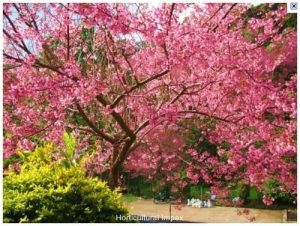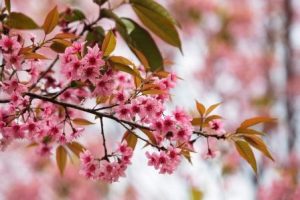BOTANICAL NAME: Prunus cerasoides
FAMILY: Rosaceae
CLASSICAL CLASSIFICATION
Charak- Vedanasthapnamahakashya, kashyaskanda
Sushrut- Sarivadigana, Chandanadigana
Bhavprash- Kapooradivarga
ENGLISH NAME: Himalayan wild cherry
COMMON NAME:
Hindi: Padmakh
Bengali: Padam


REFERENCE: BHAVAPRAKASH SAMHITA with link e Nighantu:
https://niimh.nic.in/ebooks/e-Nighantu/bhavaprakashanighantu/?mod=read
HABITAT: All over India
BOTANICAL DESCRIPTION:
A middle sized or large tree extending from Kashmir to Bhutan. Bark smooth, brown peeling off in horizontal strips Leaves are variable in length and breadth, doubly serrate Flowers are fascicles or umbels, rose red to white. Fruits drupes, ovoid , 1.25cm long , yellow and reddish Flowering time October- December. FRUITING TIME: April- May onwards.
| RASA | GUNA | VEERYA | VIPAKA | PRABHAVA | DOSHGHNTA |
| Katu, Kashya | Laghu | Sheet | Katu | Kaphpittashamak |
AYURVEDIC ENERGETICS
| TASTE | PROPERTY | POTENCY | POST DIGESTIVE ACTION | EFFECT ACTION | DOSHA ACTION |
| Bitter, Astringent | Lightness | Cold | pungent | Pacifying kaphpitta |
MAJOR CHEMICAL CONSTITUENTS: Isoflavone prunerine , sakuranetin,
Glyosidesakuranin.
THERAPEUTIC USES:
- Herpes-The power of the plant applied in the form of paste.
- Calculus-The dried powder of the seed is given in dosage of 3-5 gm to treat renal stone
INDICATIONS:
Kustha Skin disorder, Daha Burning sensation, Arsha haemorrhoids, Jwara pyrexia.
USEFUL PART: Stem bark, Seeds
DOSAGE: Heartwood powder 1-3 g
Decoction- 40-50 ml
AYURVEDIC FORMULATION:
- Mahabringaraj tail
- Chandanaditaila,
- Jatyaditaila
- Stanyajanana rasayana
